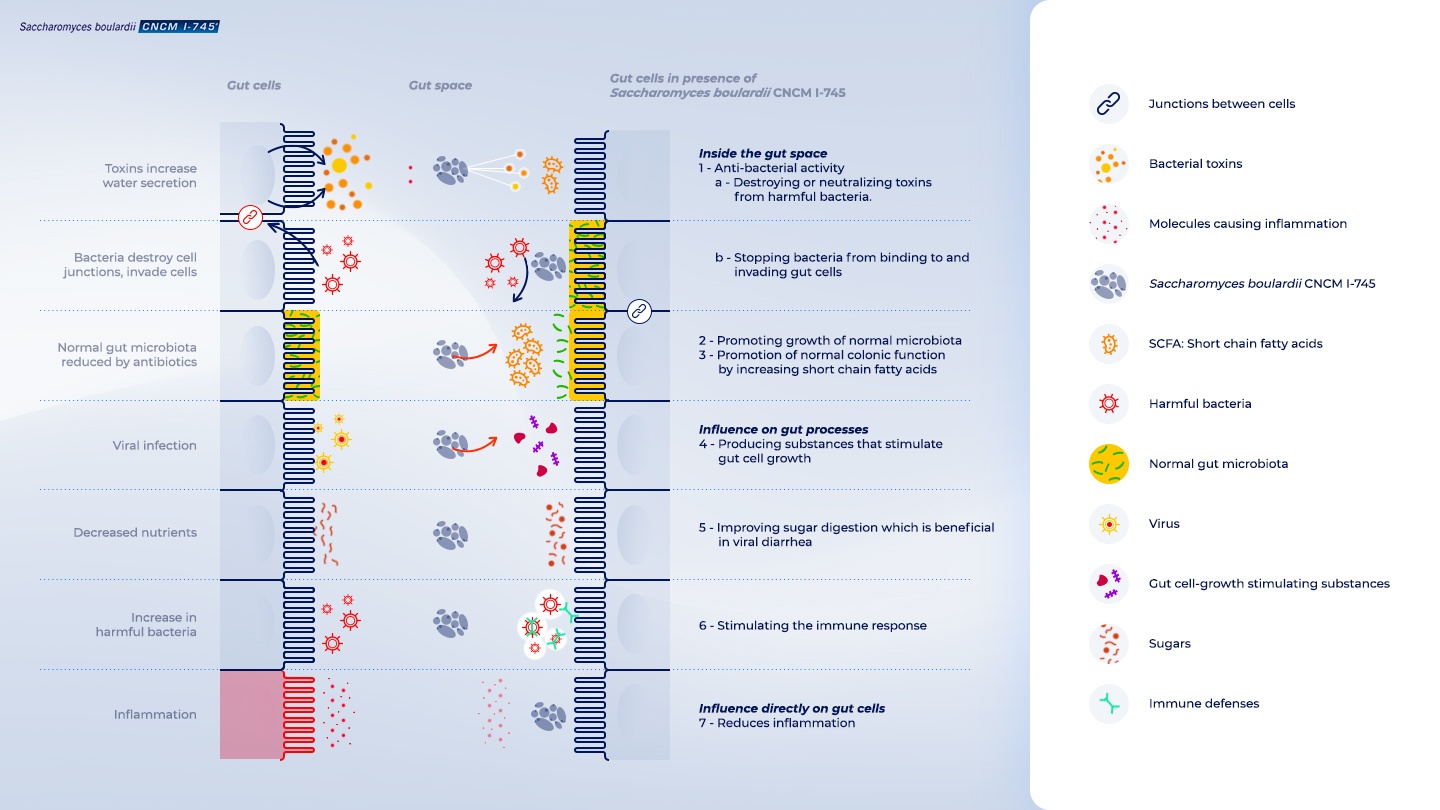S. boulardii CNCM I-745 addresses the causes and symptoms of diarrhea with specific proven mechanisms of action
- Video
- 5 min
Saccharomyces boulardii CNCM I-745 acts throughout the gut to address the causes and symptoms of diarrhea with a unique mechanism of action
Saccharomyces boulardii CNCM I-745 addresses the causes and symptoms of diarrhea through multiple strain-specific mechanisms of action1. Either it acts directly within the intestinal lumen (luminal action), indirectly to influence enzyme production (trophic action), or by affecting the mucosa including anti-inflammatory activity (mucosal action).2

(Internal code : 20.60)
The beneficial effects of Saccharomyces boulardii CNCM I-745 within the lumen
In pre-clinical investigations in animal models or models of intestinal epithelial cells, S. boulardii CNCM I-745 has been demonstrated to counteract harmful bacterial toxins by blocking receptor sites, directly binding the toxin, or producing proteins that destroy them.3
For example, one protein produced by S. boulardii CNCM I-745 inhibits the cAMP-induced increase in chloride production that are caused by Cholera Toxin, which leads to increased water secretion. The toxin can also be directly bound by S. boulardii CNCM I-745 to prevent it damaging cells.3
Another anti-toxin protein is a secreted protease that degrades Clostridium difficile toxins A and B and the corresponding receptors.3
Finally, pre-clinical animal studies have reported that S. boulardii CNCM I-745 produces a protein phosphatase that dephosphorylates Escherichia coli lipopolysaccharide, reducing inflammation.3
Besides counteracting the harmful toxins produced by pathogenic bacteria, S. boulardii CNCM I-745 also prevents their invasion of gut cells by acting as a barrier, and by preserving tight junctions.3 The yeast inhibits phosphorylation of the myosin light chain (involved in forming tight junctions), preventing increased intestinal permeability.3 It has been demonstrated that this prevents access of bacteria such as Shigella.3
In vitro scanning and microscopy studies have demonstrated that S. boulardii CNCM I-745 can bind to bacterial strains such as E. coli, S. typhimurium to prevent adhesion to gut cells.3 In vivo imaging studies showed that S. boulardii CNCM I-745 can also enhance the duration of bacterial elimination through the digestive tract.3 It has also been reported that S. boulardii CNCM I-745 can directly inhibit the growth of bacteria such as Yersinia enterocolitium.2
The indirect trophic effects of Saccharomyces boulardii CNCM I-745
Pre-clinical studies have demonstrated that S. boulardii CNCM I-745 increases intestinal enzymatic activity.2 It has been reported that S. boulardii CNCM I-745 administration is associated with an increase in:
- lactase, α-glucosidase and alkaline phosphatase that are involved in normal gut activity1 ;
- polyamine production, substances involved in enterocyte maturation1,2 ;
- disaccharidase that increases sugar digestion1, that can counteract the sugar malabsorption and subsequent osmotic diarrhea induced by rotavirus4 ;
- enhanced absorption of D-glucose coupled to Na+ and the expression of the sodium-glucose cotransporter-1 (SGLT-1) which are involved in glucose transport into cells.5
S. boulardii CNCM I-745 also indirectly increases proteolysis of small N-terminal peptides by producing a leucine aminopeptidase belonging to the zinc-metalloprotease family, which counteracts reduced nutrient digestion.6
Another trophic action is immune action, where S. boulardii CNCM I-745 has the ability to enhance host responses to the presence of pathogenic bacteria via the stimulation of secreted immunoglobulin A (sIgA). For example in mice, the administration of S. boulardii CNCM I-745 increases the levels of circulating anti-C. difficile-toxin A IgA that bind and neutralise the toxin.3
Activity of Saccharomyces boulardii CNCM I-745 on the gut mucosa
Besides acting as a physical barrier, the intestinal mucosa is a repository for pro-inflammatory compounds.1 S. boulardii CNCM I-745 acts on the intestinal mucosa to decrease the synthesis of pro-inflammatory cytokines It produces a small anti-inflammatory factor (Saccharomyces anti-inflammatory factor; butyrate, both linked to inhibition of mitogen-activated protein kinases (MAPK) and NF-κB activity.1 This inhibition results in decreased expression of inflammatory cytokines such IL-8 , IFN-ϒ, TNF-α and IL-6.1
Saccharomyces boulardii CNCM I-745 indirectly affects gut function and microbiota composition that leads to restoration of a healthy gut
The administration of S. boulardii CNCM I-745 has been associated with an increase in short-chain fatty acids (SCFA), in particular butyrate and propionate.3 These compounds play a role in normal colonic function, including fluid absorption.3
Through its multiple mechanisms of action, S, boulardii CNCM I-745 creates a favourable growth environment for normal microbiota.7 Studies assessing fecal composition have shown that during dysbiosis, when there is a disturbance to the balance of gut microbiota, normal composition and diversity are restored rapidly upon administration of S. boulardii CNCM I-745 while overgrown species are reduced.7 However, in healthy individuals, S. boulardii CNCM I-745 does not affect gut microbiota composition nor diversity.2
Internal code : 20.03
References
- 01 . Marteau, P and Dore J (Ed.). Gut Microbiota: A full-fledged organ. 2017: 305-326. Paris: John Libbey Eurotext.
- 02 . McFarland, LV. Systematic review and meta-analysis of Saccharomyces boulardii in adult patients. World journal of gastroenterology: WJG. 2010; 16(18): 2202.
- 03 . Czerucka D, and Rampal, P. Diversity of Saccharomyces boulardii CNCM I-745 mechanisms of action against intestinal infections. World journal of gastroenterology. 2019; 25(18): 2188.
- 04 . Graham DY, Sackman JW, and Estes, MK. Pathogenesis of rotavirus-induced diarrhea. Digestive diseases and sciences. 1984; 29(11): 1028-1035.
- 05 . Röder PV, et al. The role of SGLT1 and GLUT2 in intestinal glucose transport and sensing. PloS one. 2014; 9(2). doi: 10.1371/journal.pone.0089977
- 06 . Buts JP, et al. Saccharomyces boulardii enhances N-terminal peptide hydrolysis in suckling rat small intestine by endoluminal release of a zinc-binding metalloprotease. Pediatric research. 2002; 51(4): 528.
- 07 . More MI, and Swidsinski, A. Saccharomyces boulardii CNCM I-745 supports regeneration of the intestinal microbiota after diarrheic dysbiosis–a review. Clinical and experimental gastroenterology. 2015; 8: 237.
